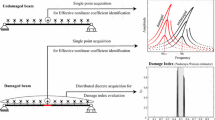Abstract
A non-linear perturbation theory which furnishes an exact relationship between the perturbation of structural parameters and the perturbation of modal parameters is presented. A system of governing equations is derived, where the information about incomplete modal data can be directly adopted. The Direct Iteration and the Gauss–Newton Least Squares techniques for an inverse prediction of structural damage are discussed, where both the location and the extent of structural damage can be correctly determined using only a limited amount of incomplete modal measurements data. Structural damage is assumed to be associated with a proportional reduction of the original element stiffness matrix or with a proportional reduction of the contribution of a Gauss point to the element stiffness matrix, which characterises a structure at an element level or at a Gauss point level. Finally, a damaged cantilever beam is considered using different model problems to demonstrate the effectiveness of the proposed techniques.
Similar content being viewed by others
References
Bicanic N, Chen HP (1997) Damage identification in framed structures using natural frequencies. Int J Numer Meth Eng 40:4451–4468
Cawley P, Adams RD (1979) The location of defects in structures from measurements of natural frequencies. J Strain Anal 14(2):49–57
Chen HP, Bicanic N (2000) Assessment of damage in continuum structures based on incomplete modal information. Comput Struct 74:559–570
Chen JC, Garba JA (1988) On-orbit damage assessment for large space structures. AIAA J 26(9):1119–1126
Farhat C, Hemez FM (1993) Updating finite element dynamic models using an element-by-element sensitivity methodology. AIAA J 31( 9):1702–1711
Gallego R, Rus G (2004) Identification of cracks and cavities using the topological sensitivity boundary integral equation. Comput Mech 33(2):154–163
Kabe AM (1985) Stiffness matrix adjustment using modal data. AIAA J 23(9): 1431–1436
Kammer DC (1991) A hybrid approach to test-analysis model development for large space structures. J Vib Acoust 113:325–332
Natke HG, Cempel C (1997) Model-aided diagnosis of mechanical systems. Springer, Berlin Heidelberg New York
Ojalvo IU, Zhang LM (1993) Tutorial:Fundamentals of ill-conditioning. Modal Analysis IJAEMA 8(2):165–176
Rhim J, Lee SW (1995) A neural network approach for damage detection and identification of structures. Comput Mech 16(6):437–443
Ricles JM, Kosmatka JB (1992) Damage detection in elastic structures using vibratory residual forces and weighted sensitivity. AIAA J 30(9):2310–2316
Stubbs N, Broome TH, Osegueda R (1990) Nondestructive construction error detection in large space structures. AIAA J 28(1):146–152
To WM, Ewins DJ (1991) Non-linear sensitivity analysis of mechanical structures using modal data. J Mech Eng Sci, (Proc Instn Mech Engrs) 205:67–75
Zhang Q, Lallement G (1987) Dominant error localisation in a finite element model of a mechanical structure. Mech Sys Signal Pro 1:141–149
Zimmerman DC, Kaouk M (1994) Structural damage detection using a minimum rank updating theory. J Vibration Acoust, Transaction of ASME 116(1):222–231
Author information
Authors and Affiliations
Corresponding author
Rights and permissions
About this article
Cite this article
Chen, HP., Bicanic, N. Inverse damage prediction in structures using nonlinear dynamic perturbation theory. Comput Mech 37, 455–467 (2006). https://doi.org/10.1007/s00466-005-0717-y
Received:
Accepted:
Published:
Issue Date:
DOI: https://doi.org/10.1007/s00466-005-0717-y




